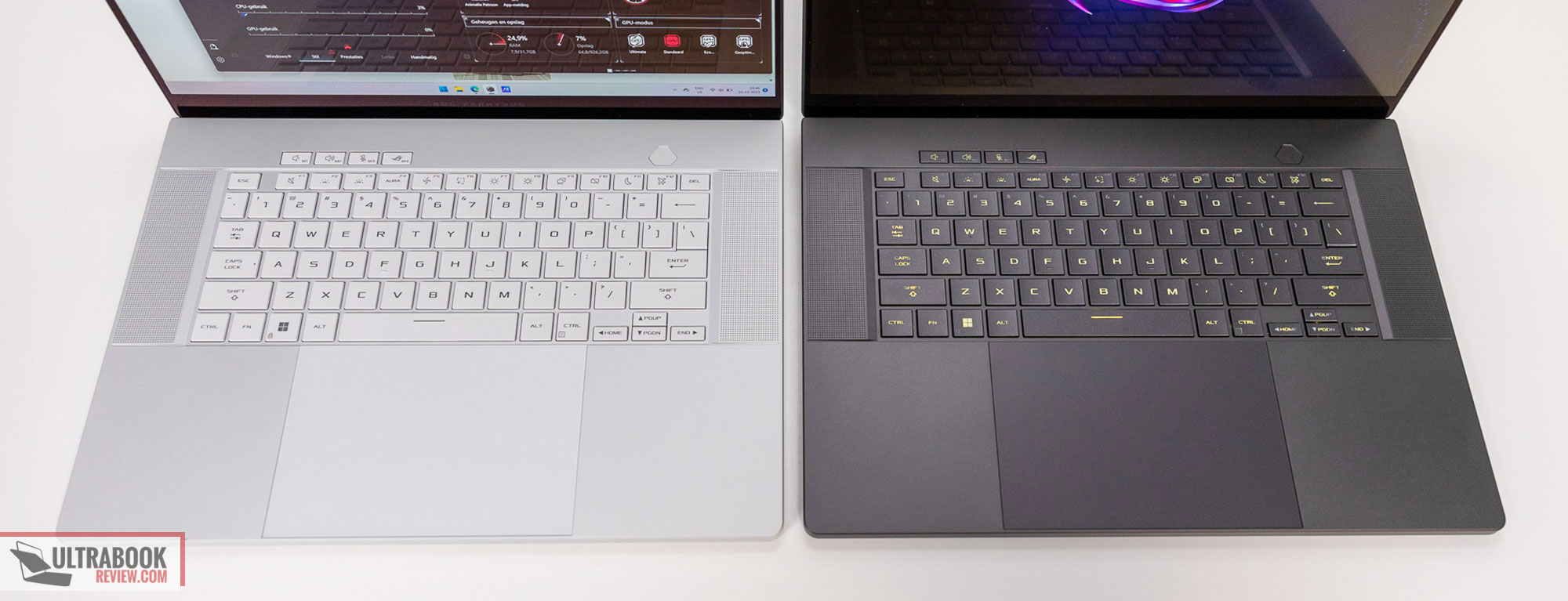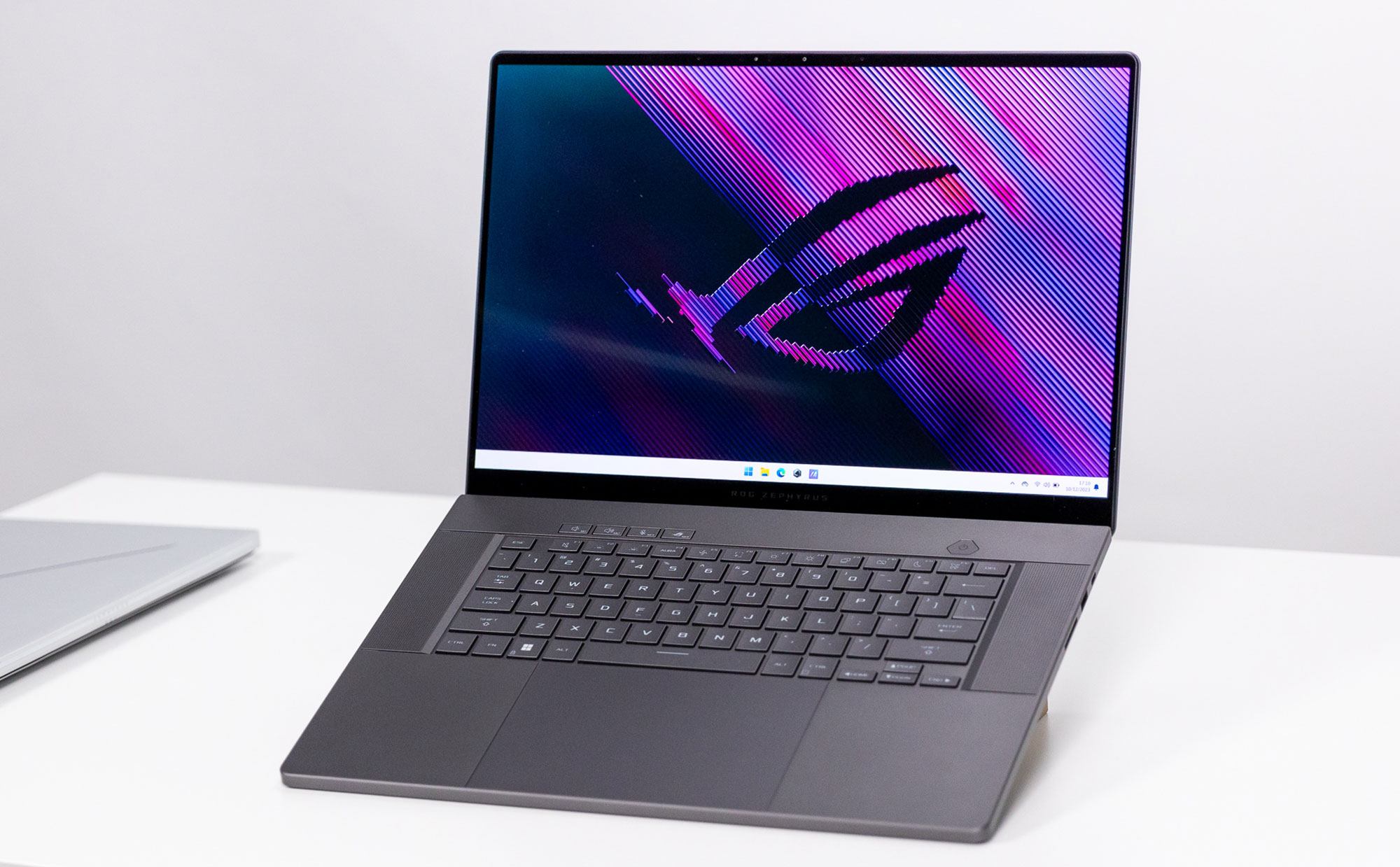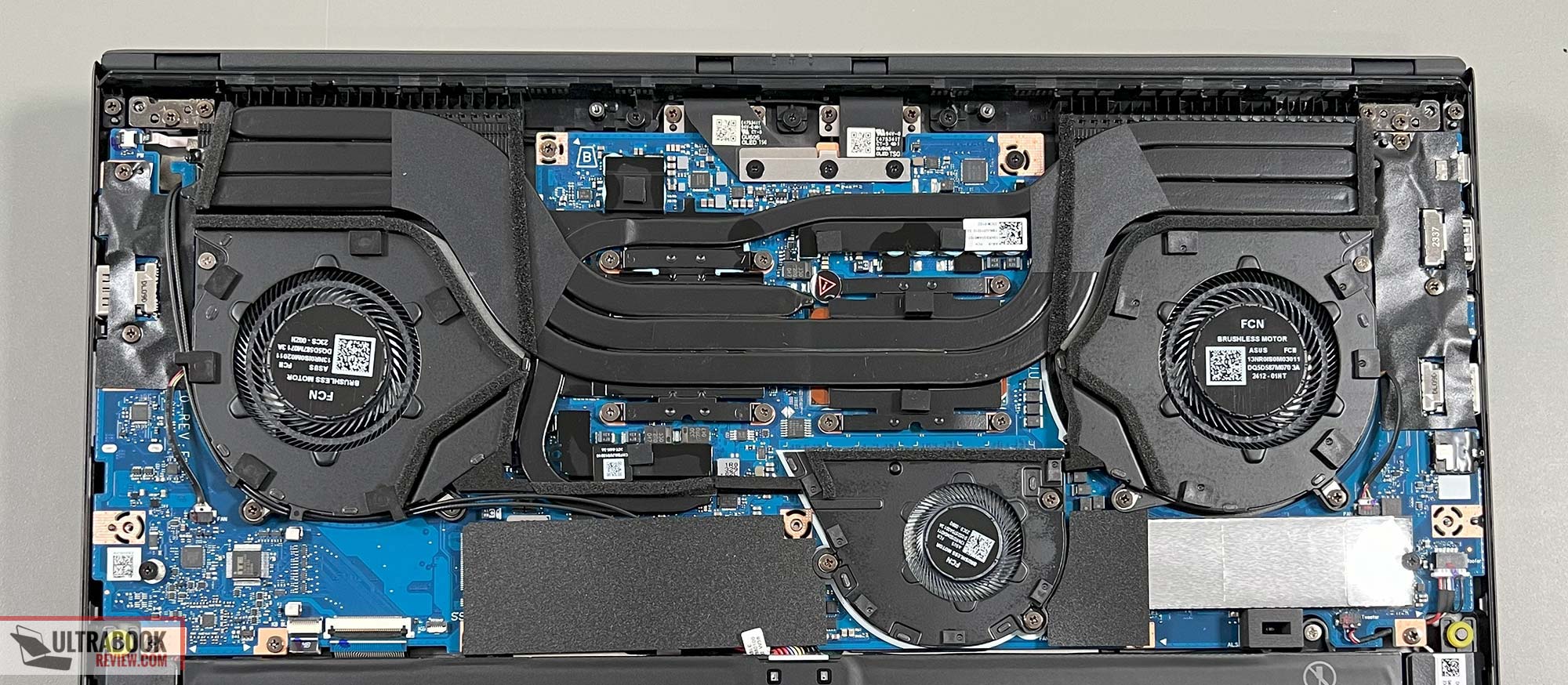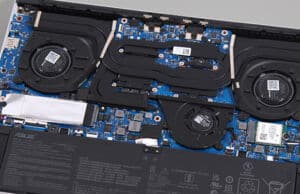Table of Contents
So there’s a new AMD ROG Zephyrus G16 GA605W model coming later in 2024, this time built on the latest AMD Ryzen AI hardware, part of the AMD Strix Point platform.
This will be offered alongside the existing Zephyrus G16 GU605M models built on Intel Meteor Lake hardware, which we’ve already reviewed here: the Core Ultra 7 + RTX 4070 Zephyrus G16 variant, and the top Core Ultra 9 + RTX 4090 Zephyrus G16 model.
However, there’s an important catch: while there are two hardware versions available for the Intel model, one for the mid-tier configurations (up to 4070) and another for the top-tier models (4080/4090), slightly heavier and with a vapor-chamber inside for cooling, the AMD model is only available in the base-level hardware designs.
That means it can only be specced up to an Nvidia GeForce RTX 4070 graphics chip, alongside an AMD Strix Point Ryzen AI 9 370 HX processor, up to 32 GB of LPDDR5X-7500 RAM, and the tri-fan cooling design we’ve already tested on the RTX 4070 G16 model a few months ago. More on that in a bit, because it is important!
AMD Strix Point Zephyrus G16, vs. Intel Meteor Lake G16 variants
But first, here’s the specs sheet for this AMD-based Zephyrus G16, next to the Intel-based models.
| 2024 ASUS ROG Zephyrus G16 GU605W | 2024 ASUS ROG Zephyrus G16 GU605M | |
| Display | 16-inch, 16:10, non-touch, OLED QHD+ 2560 x 1600 px , 240 Hz VRR 0.2ms, 400 nits SDR, 100% DCI-P3 colors, glossy, anti-glare |
|
| Processor | AMD Strix Point, Ryzen AI 9 370 HX, 12C/24T | Intel Meteor Lake, Core Ultra 9 185H, 16C/22T |
| Video | Radeon 800M + up to Nvidia RTX 4070 8GB (up to 105W with Dyn Boost) on the GU605WI version with MUX, Advanced Optimus, and GSync |
Arc + up to Nvidia RTX 4090 16GB (up to 115W with Dyn Boost) on the GU605MY version with MUX, Advanced Optimus, and GSync |
| Memory | 32 GB LPDDR5x-7500 (onboard) | 32 GB LPDDR5x-7467 (onboard) |
| Storage | 2x M.2 PCI 4.0 x4 slots | 2x M.2 PCI 4.0 x4 slots |
| Connectivity | WiFi 7 2×2 with Bluetooth 5.4 | WiFi 6E 2×2 with Bluetooth 5.3 |
| Ports | left: DC-in, HDMI 2.1 FRL, 1x USB-C 4.0, 1x USB-A 3.2, audio jack right: 1x USB-A 3.2, 1x USB-C gen2 (with data, DP, PD), SD Express 7.0 card reader |
left: DC-in, HDMI 2.1 FRL, 1x USB-C Thunderbolt 4.0, 1x USB-A 3.2, audio jack right: 1x USB-A 3.2, 1x USB-C gen2 (with data, DP, PD), SD UHS-II card reader |
| Battery | 90 Wh, 240 W power adapter, USB-C charging up to 100W | |
| Size | 354 mm or 13.96” (w) x 246 mm or 9.68 (d) x from 14.9 or .658” (h) | |
| Weight | from 1.85 kg (4.1 lbs), .72 kg (1.58 lbs) for the 240W main power brick and cables, EU version |
from 1.85 kg (4.1 lbs) for the RTX 4060/4070 versions, from 1.95 kg (4.3 lbs) for the RTX 4080/4090 versions, .72 kg (1.58 lbs) for the 240W main power brick and cables, EU version |
| Extras | clamshell format with 130-degree hinge, cleaner design and updated lightbar design on the lid, updated single-zone RGB keyboard and larger glass touchpad, updated 6x speakers – 10W, FHD webcam with IR, dual-fan vapor-chamber cooling only on the Intel-based RTX 4080/4090 models, available in silver or gray variants |
|
So, in just a few words, this AMD variant of the Zephyrus G16 shares the exact same chassis currently offered in the RTX 4050 to RTX 4070 configurations of the Zephyrus G16 GU605, which we’ve discussed in depth in this review and this earlier first-impressions article.
It’s a premium design with excellent inputs and mostly solid ergonomics, with the exception of the limited screen angle that only allows to set it back to about 130 degrees. That’s on par with the MacBook Pro, for what is worth, but a specific aspect that bothers me on supposedly portable laptops, even such as these with a larger display.
I’ll just mention that the AMD model only comes in the slightly more lightweight chassis version that starts at just a little over 4.1 lbs, while the Intel models are available in two chassis variants, one being heavier by about 100 grams / .2 lbs.
That side, Asus offers this AMD variant in two color options, light silver or darker gray, just like on the Intel-based model. I prefer the darker grey, but the silver is more carefree as it doesn’t smudge nearly as easily.
These below are pictures of the Intel models, but the AMD versions are just the same, just with different stickers on the armrest.
There’s also the same display on all these G16 variations, the spectacular 16-inch 16:10 OLED panel with 240Hz refresh and punchy colors and image quality. As long as you’re OK with the particularities of OLED displays on laptops, this is the as good as it gets today.
And the same speakers, which once more, are punchy and loud and among the best available in a notebook format today.
AMD Strix Point hardware
The elephant in the room is, of course, the hardware platform inside this Zephyrus G16 GU605W series: AMD’s latest Strix Point hardware launched in mid 2024.
There’s still a fair bit until we can discuss the real-life performance of this hardware, but expect great things. As far as specs go, the AMD Ryzen AI 9 370 HX processor that powers this lineup of notebooks is the top mobile Strix Point SKU, with 12 Zen 5 Core, 24 Threads, 32 MB of cache memory, and maximum speeds of up to 5.1 GHz. This is a hybrid architecture with 4x Zen 5 high-performance cores, and 8x Zen5c more compact and efficient cores.
That’s paired with up to 32 GB of LPDDR5x-7500 memory, onboard and non-upgradeable, 2x SSD slots, plus AMD’s Ryzen AI XDNA 2 NPU, the integrated Radeon™ 890M graphics (based on RDNA 3.5 hardware), as well as dedicated graphics from Nvidia, up to a GeForce RTX 4070 8 GB.
I’ll also mention that Asus will ship this G16 variant with a WiFi 7 module, being the first ROG laptop available with Wireless 7 out of the box.
So I have solid expectations of overall performance from this AMD platform, both for single and multi-threaded loads.
However, I’m not fond that Asus limited this model to mid-tier graphics only, especially since the performance difference from the 4070 to the 4080/4090 is significant, north of 25%.
Plus, the 4080/4090 SKUs on the Intel models run at higher TGP, and benefit from more advanced cooling with the vapor-chamber, which actually allow for better thermals in sustained loads. In comparison, the more standard cooling that will be available on this laptop comes with an array of heatpipes and three fans, which at least on the Intel model, lead to high sustained temperatures in games and demanding workloads. So there’s that, and I expect quite a few potential buyers to complain about this decision.
For illustration, this is the cooling on the Intel-based RTX 4070 model. Id’ expect more or less the same for the AMD version.
On the other hand, the existing models should keep competitive in pricing, and at least cater to a segment that targets a lager audience, in the 1500-2000 USD/EUR range.
Currently, the Zephyrus G16 GU605MI (Core Ultra 9, RTX 4070) is listed at $1999 at Best Buy, but with occasional discounts. I’d expect the AMD variant, when available later in the year, to cost about the same, maybe a little more. But, by that time there’s a good chance the Intel version will get more permanent discounts, so we’ll see which is going to be the better buy later in the year.
Anyway, that’s about it for now. Looking forwards to spending more time with a finalized version of this laptop and draw some proper conclusions in the review. In the meantime, I’m curious about your thoughts on this update, and specific aspects that you might want me to look over in the review.

















Gdawg
June 5, 2024 at 8:16 pm
Asus really double down on stupid the 3 fan setup is a disaster, whatever about limiting to 4070 is bad enough but it's a no buy with the noisy annoying 3rd fan, and so expensive in Europe for this cheap cooling, hard pass, go for the yoga pro 9i for 800 euro less with 4070 and good cooling great speakers and zcreen
Myron
June 6, 2024 at 3:56 pm
Is this right? "Strix Point SKU, with 12 Zen 5 Core, 24 Threads, 32 GB of cache memory"
I'm thinking its 32 MB of cache lol
Rawr
June 7, 2024 at 5:54 am
Best G16 combo:
-Make it a bit larger but stay within the ultra-portable frame or limitation so as to up the TDP a bit more (150w [130-135w gpu + 15w rest]) for 4080/4090 variants and give side vents for the gpu fans to blow out of instead of just the back. Best of both worlds imo with a slight performance loss but still far better than the 130w limitation (115w gpu + 15w rest).
-Wifi 7 + BT 5.4
-Unsoldered RAM for 32-64 or more (although this isn't too important for me)
-AMD 9 370 HX
They basically limited the potential by adding a great and a bad to make it mediocre. 185H with 4080/4090 and 370 HX with only up to 4070. Should be a 370 HX + 4080/4090 (vapor chamber variant and not the 3 fan crap) + higher TDP limit by giving it more surface area to breath.
Anders
June 9, 2024 at 9:20 am
The CPU performance of Strix Point (Zen5) will be interesting.
But if I should update my laptop, I also want major increased GPU performance vs mobile 3070 140W.
So then a 4080 or 5070 or higher is the way to go I think.
asusux
June 21, 2024 at 9:53 am
"32 GB onboard and non-upgradeable". What a joke.